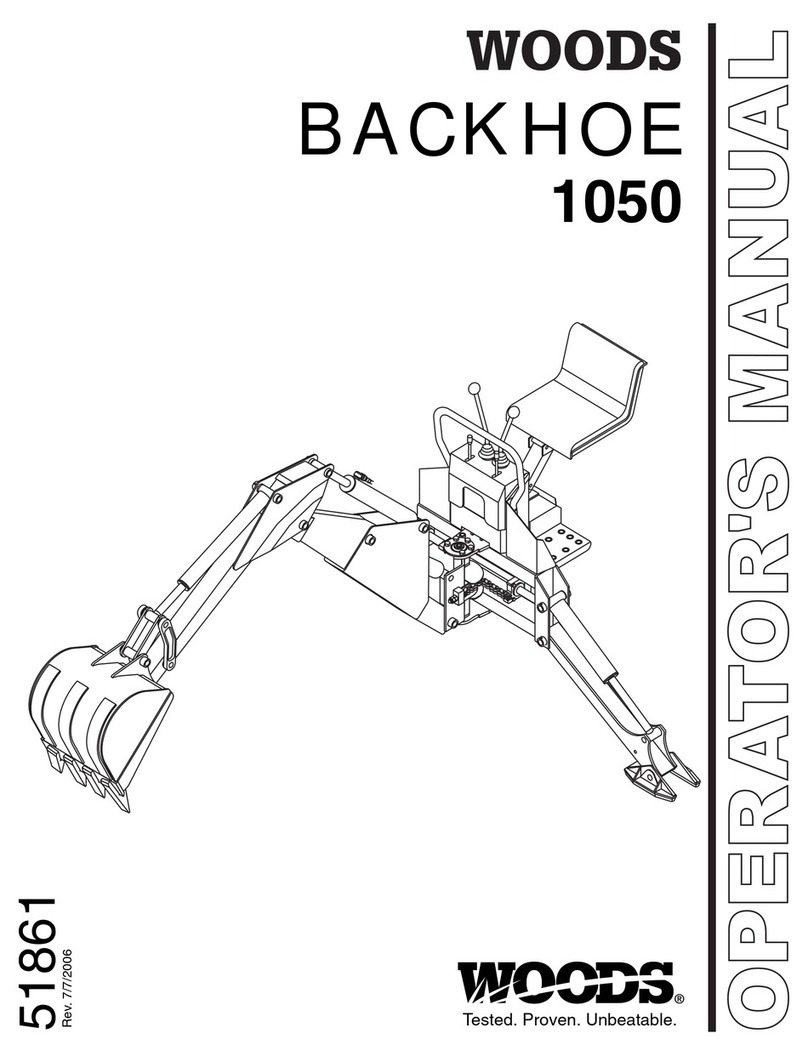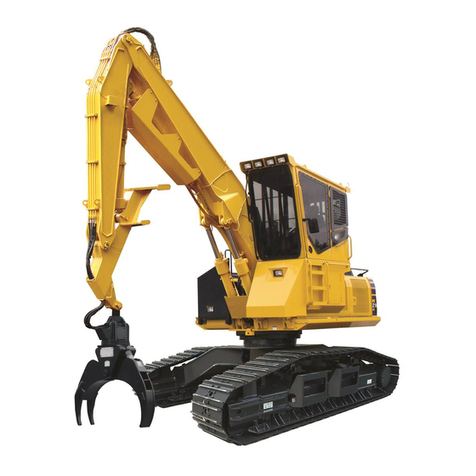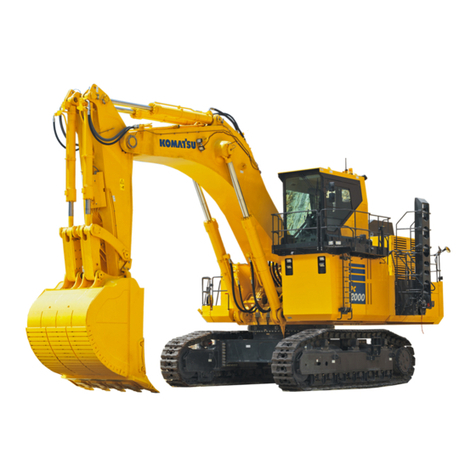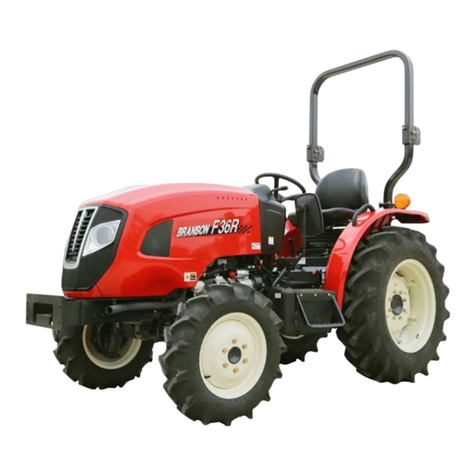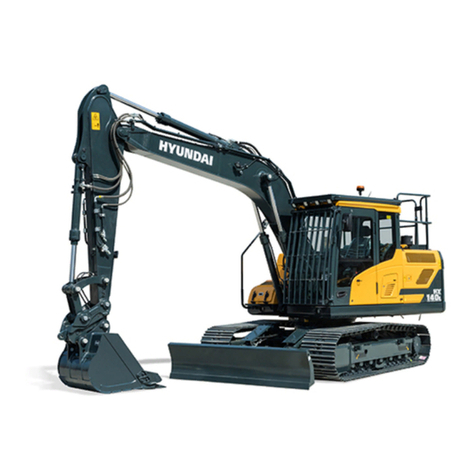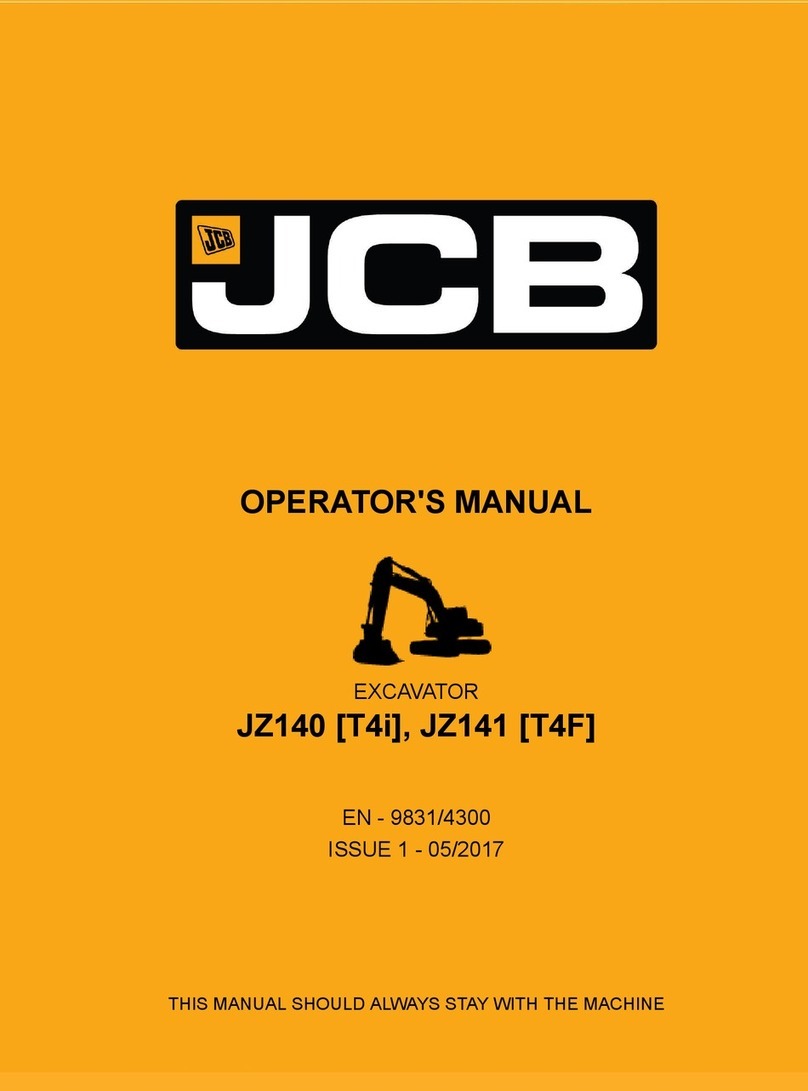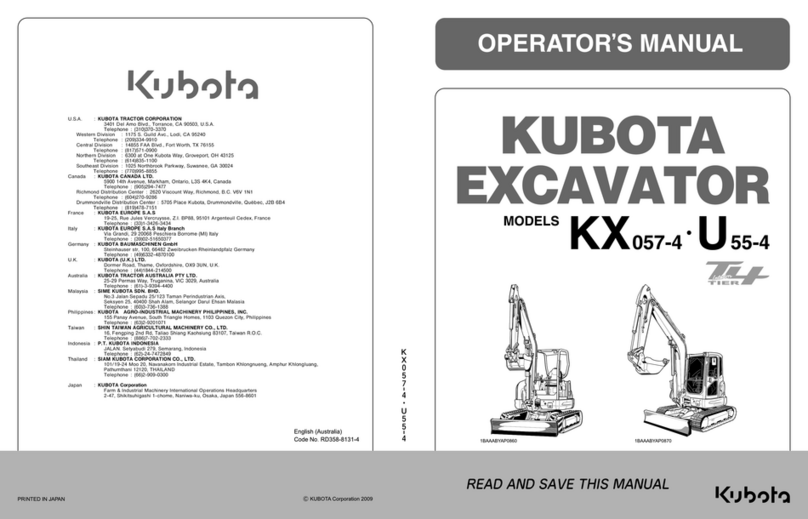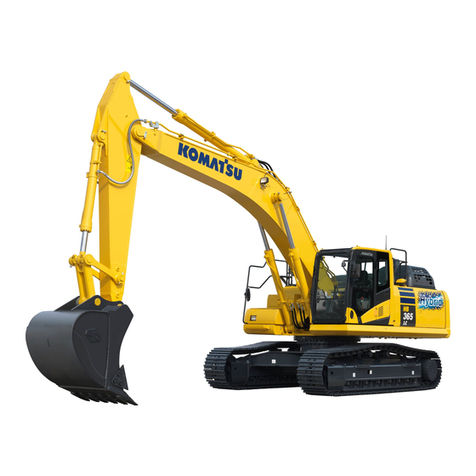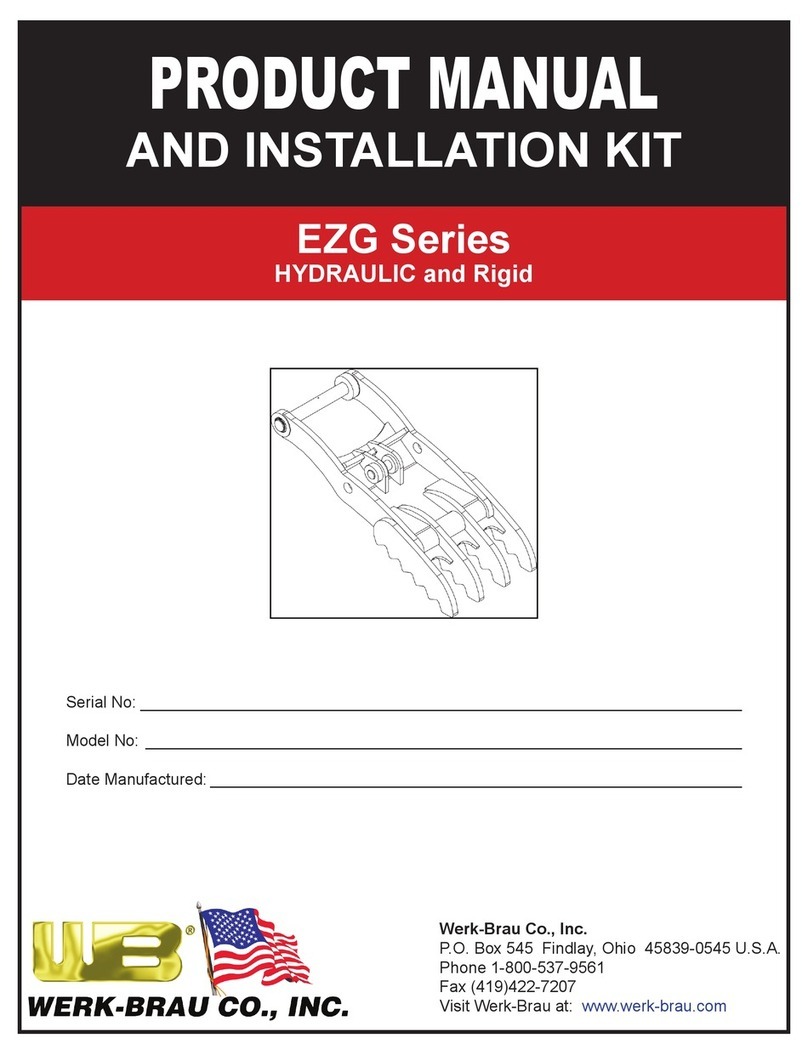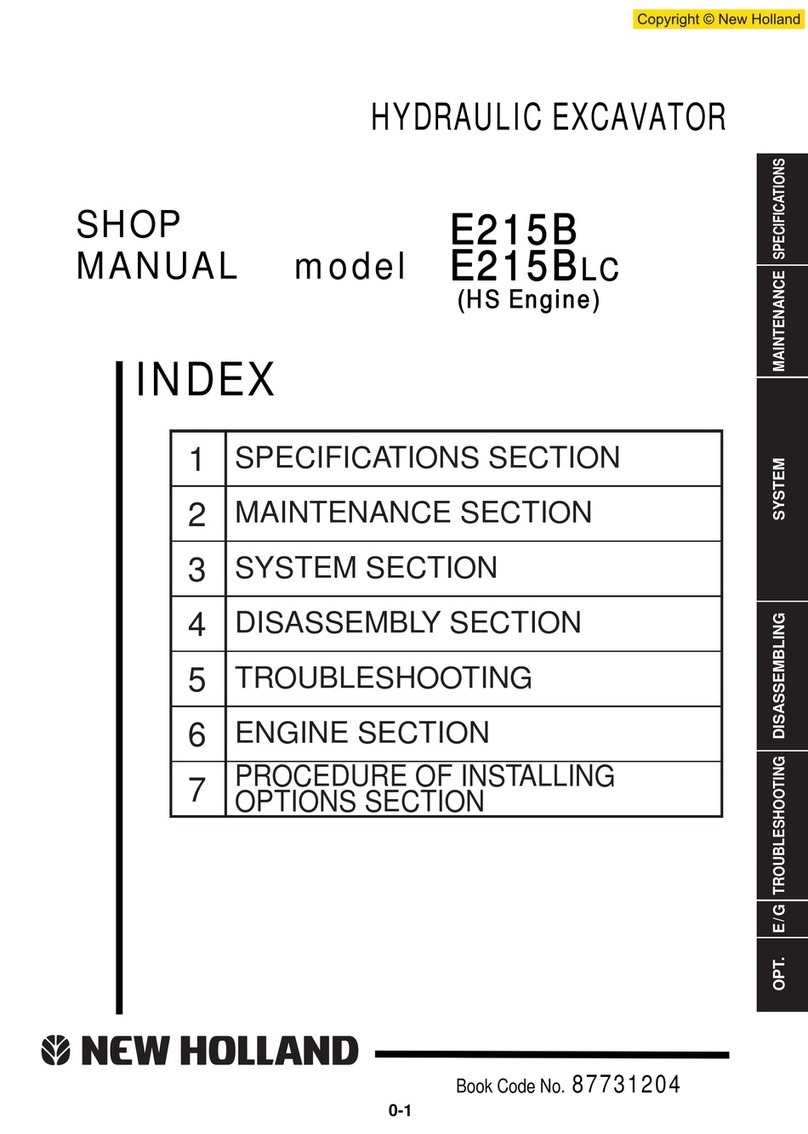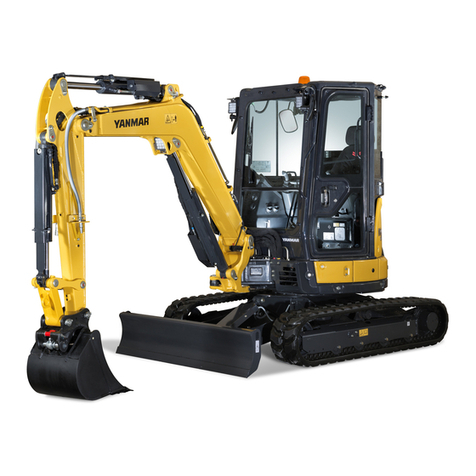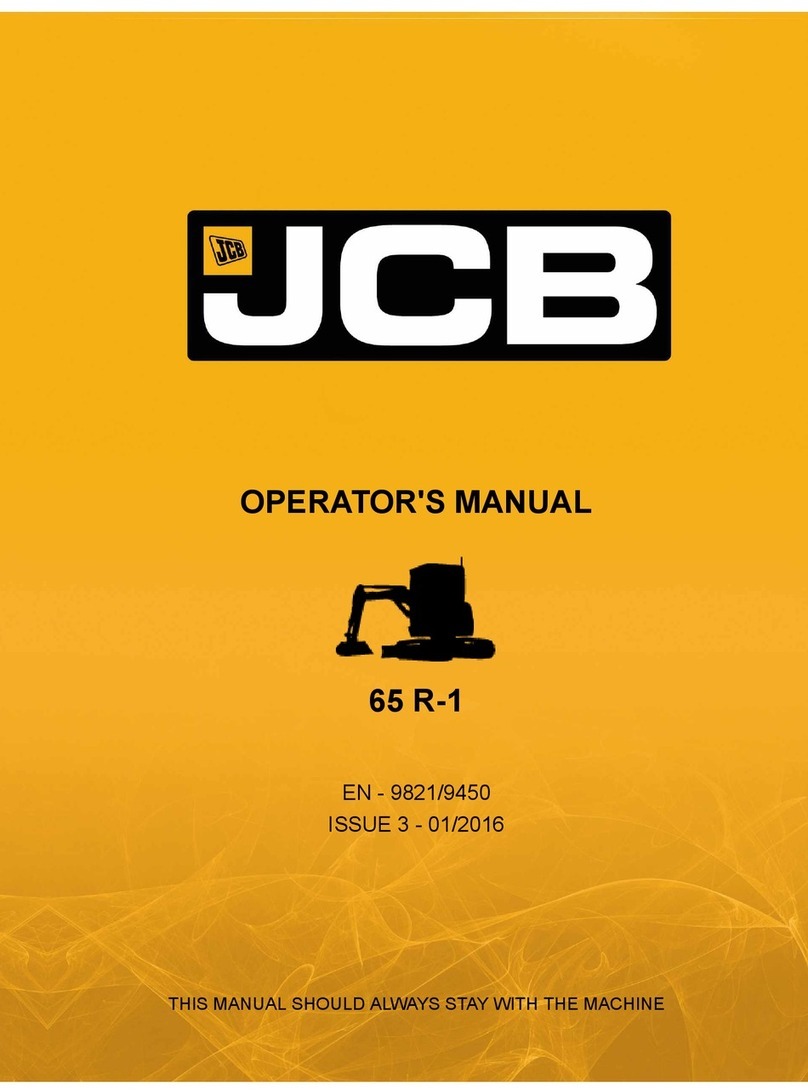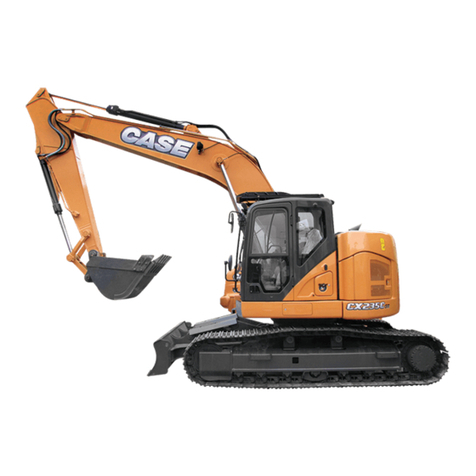Woods BH6500 User manual

OPERATOR'S MANUAL
BACKHOE
37541
Rev. 4/14/2006
Tested. Proven. Unbeatable.
BH6500
BH7500

ii Introduction
Gen’l (Rev. 5/23/2005)
TO THE DEALER:
Assembly and proper installation of this product is the responsibility of the Woods®dealer. Read manual instructions
and safety rules. Make sure all items on the Dealer’s Pre-Delivery and Delivery Check Lists in the Operator’s Manual
are completed before releasing equipment to the owner.
The dealer must complete the Product Registration included with the Operator’s Manual. The customer must sign the
registration which certifies that all Dealer Check List items have been completed. The dealer is to return the prepaid
postage portion to Woods, give one copy to the customer, and retain one copy. Failure to complete and return this
card does not diminish customer’s warranty rights.
TO THE OWNER:
Read this manual before operating your Woods equipment. The information presented will prepare you to do abetter and
safer job. Keep this manual handy for ready reference. Require all operators to read this manual carefully and become
acquainted with all adjustment and operating procedures before attempting to operate. Replacement manuals can be
obtained from your dealer. To locate your nearest dealer, check the Dealer Locator at www.WoodsEquipment.com, or in
the United States and Canada call 1-800-319-6637.
The equipment you have purchased has been carefully engineered and manufactured to provide dependable and
satisfactory use. Like all mechanical products, it will require cleaning and upkeep. Lubricate the unit as specified.
Observe all safety information in this manual and safety decals on the equipment.
For service, your authorized Woods dealer has trained mechanics, genuine Woods service parts, and the necessary
tools and equipment to handle all your needs.
Use only genuine Woods service parts. Substitute parts will void the warranty and may not meet standards required for
safe and satisfactory operation. Record the model number and serial number of your equipment in the spaces
provided:
Model:_______________________________ Date of Purchase: _____________________
Serial Number: (see Safety Decal section for location) ____________________________________
Provide this information to your dealer to obtain correct repair parts.
Throughout this manual, the term IMPORTANT is used to indicate that failure to observe can cause damage to
equipment. The terms CAUTION, WARNING, and DANGER are used in conjunction with the Safety-Alert Symbol (a
triangle with an exclamation mark) to indicate the degree of hazard for items of personal safety.
CAUTION
CAUTION
IMPORTANT
IMPORTANT
WARNING
WARNING
DANGER
DANGER
NOTE
NOTE
This Safety-Alert Symbol indicates a hazard and means ATTENTION!
BECOME ALERT! YOUR SAFETY IS INVOLVED!
Indicates an imminently hazardous situation that, if not avoided, will
result in death or serious injury.
Indicates a potentially hazardous situation that, if not avoided, could
result in death or serious injury, and includes hazards that are exposed
when guards are removed.
Indicates a potentially hazardous situation that, if not avoided, may
result in minor or moderate injury.
Indicates that failure to observe can cause damage to equipment.
Indicates helpful information.

Introduction 1
37541 (Rev. 1/30/2004)
TABLE OF CONTENTS
INTRODUCTION. . . . . . . . . . . . . . . . . . . . . . . . . . . . . . . . . . . . . . . . . . . . . . .ii
SPECIFICATIONS
BH6500 . . . . . . . . . . . . . . . . . . . . . . . . . . . . . . . . . . . . . . . . . . . . . . . . . . . . . 2
BH7500 . . . . . . . . . . . . . . . . . . . . . . . . . . . . . . . . . . . . . . . . . . . . . . . . . . . . . 4
GENERAL INFORMATION . . . . . . . . . . . . . . . . . . . . . . . . . . . . . . . . . . . . . . 6
SAFETY RULES . . . . . . . . . . . . . . . . . . . . . . . . . . . . . . . . . . . . . . . . . . . . . . 7
SAFETY DECALS . . . . . . . . . . . . . . . . . . . . . . . . . . . . . . . . . . . . . . . . . . . . 10
OPERATION . . . . . . . . . . . . . . . . . . . . . . . . . . . . . . . . . . . . . . . . . . . . . . . . 12
OWNER SERVICE . . . . . . . . . . . . . . . . . . . . . . . . . . . . . . . . . . . . . . . . . . . 18
TROUBLE-SHOOTING . . . . . . . . . . . . . . . . . . . . . . . . . . . . . . . . . . . . . . . . 21
DEALER CHECK LIST . . . . . . . . . . . . . . . . . . . . . . . . . . . . . . . . . . . . . . . . 22
DEALER SERVICE . . . . . . . . . . . . . . . . . . . . . . . . . . . . . . . . . . . . . . . . . . . 23
ASSEMBLY . . . . . . . . . . . . . . . . . . . . . . . . . . . . . . . . . . . . . . . . . . . . . . . . . 28
INDEX TO PARTS LISTS . . . . . . . . . . . . . . . . . . . . . . . . . . . . . . . . . . . . . . 37
BOLT TORQUE CHART . . . . . . . . . . . . . . . . . . . . . . . . . . . . . . . . . . . . . . . 52
BOLT SIZE CHART & ABBREVIATIONS . . . . . . . . . . . . . . . . . . . . . . . . . . 53
INDEX . . . . . . . . . . . . . . . . . . . . . . . . . . . . . . . . . . . . . . . . . . . . . . . . . . . . . 54
PRODUCT WARRANTY . . . . . . . . . . . . . . . . . . . . . . . INSIDE BACK COVER
REPLACEMENT PARTS WARRANTY . . . . . . . . . . . . . . . . . . .BACK COVER
Si no lee Ingles, pida ayuda a
alguien que si lo lea para que le
traduzca las medidas de seguridad.
LEA EL INSTRUCTIVO!
!

2 Introduction
37541 (Rev. 1/30/2004
BH6500 SPECIFICATIONS
REACH BELOW GRADE (STANDARD BUCKET)
Maximum 79.5" 2019mm
With two-foot flat bottom trench* 78" 198mm
LOADER HEIGHT* 52.5" 1334mm
REACH
From center of swing mast pivot point* 94" 2388mm
BUCKET ARC 180°
SWING WORKING ARC 180°
OPERATING PRESSURE
Digging* 2100 psi 14.5 MPa
Swing* 2100 psi 14.5 MPa
STABILIZER SPREAD 59" - 88" 1499 - 2235mm
BOOM CYLINDER
Bore 2.5" 63.5mm
Stroke 16.75" 425.5mm
DIPPERSTICK CYLINDER
Bore 2.0" 50.8mm
Stroke 16.75" 425.5mm
Digging Force* 1284 lbs. 5,725 N
BUCKET CYLINDER
Bore 2.0" 50.8mm
Stroke 16.75" 425.5mm
Digging Force* 2500 lbs. 11,150 N
SWING CYLINDER
Bore 2.5" 63.5mm
Stroke 10.62" 269.7mm
BUCKET RATED CAPACITY
8-Inches .71 ft.3020m3
12 Inches 1.44 ft.3041m3
16 Inches 1.66 ft.3047m3
18 Inched 1.93 ft.3055m3
24 Inches 2.73 ft.3077m3
* Per SAE J49 Standards

Introduction 3
37541 (Rev. 1/30/2004)
BH6500
in

4 Introduction
37541 (Rev. 1/30/2004
BH7500 SPECIFICATIONS
REACH BELOW GRADE (STANDARD BUCKET
Maximum 91.8" 2332mm
With two-foot flat bottom trench* 90.0" 2286mm
LOADEDR HEIGHT* 68.0" 1727mm
REACH
From center of swing mast pivot point* 112" 2845mm
BUCKET ARC 180°
SWING WORKING ARC 180°
OPERATING PRESSURE
Digging* 2100 psi 14.5 MPa
Swing* 2100 psi 14.5 MPa
STABILIZER SPREAD 59" - 88" 1499 - 2235mm
BOOM CYLINDER
Bore 2.5" 63.5mm
Stroke 16.75" 425.5mm
DIPPERSTICK CYLINDER
Bore 2.0" 50.8mm
Stroke 16.75" 425.5mm
Digging Force* 1786 lbs. 7,964 N
BUCKET CYLINDER
Bore 2.0" 50.8mm
Stroke 16.75" 425.5mm
Digging Force* 2500 lbs. 11,150 N
SWING CYLINDER
Bore 2.5" 63.5mm
Stroke 10.62" 269.7mm
BUCKET RATED CAPACITY
8 Inches .71 ft.3020m3
12 Inches 1.44 ft.3041m3
16 Inches 1.66 ft.3047m3
18 Inched 1.93 ft.3055m3
24 Inches 2.73 ft.3077m3
* Per SAE J49 Standards

Introduction 5
37541 (Rev. 1/30/2004)
BH7500

6 Introduction
37541 (Rev. 1/30/2004
GENERAL INFORMATION
The purpose of this manual is to assist in setting up,
operating and maintaining your backhoe. Read it care-
fully. It furnishes information and instructions that will
help you achieve years of dependable performance.
These instructions have been compiled from extensive
field experience and engineering data. Some informa-
tion may be general in nature due to unknown and
varying conditions. However, through experience and
these instructions, you should be able to develop pro-
cedures suitable to your particular situation.
The illustrations and data used in this manual were cur-
rent at the time of printing, but due to possible in-line
production changes, your machine may vary slightly in
detail. We reserve the right to redesign and change the
machines as may be necessary without notification.
■ Some illustrations in this manual show the
backhoe with safety shields removed to provide a
better view. The backhoe should never be operated
with any safety shielding removed.
Figure 1. Backhoe Directions
Throughout this manual, references are made to right,
left, forward and rearward directions. These are deter-
mined from the backhoe operator seat position facing
rearward as shown in Figure 1.
Terms for backhoe components have some variations
throughout the industry. We use SAE designations as
shown in Figure 2.
Figure 2. Backhoe Components
WARNING
12
11 10
9
8
7
6
5
4
3
2
1
CD4640A
1. Bucket
2. Bucket cylinder
3. Dipperstick cylinder
4. Boom cylinder
5. Console
6. Stabilizer
7. Swing cylinder
8. Boom
9. Dipperstick
10. Stabilizer cylinder
11. Swing frame
12. Main frame

Safety 7
BH6500/7500/9000_SR (11/14/2003)
INSTALLATION
Hydraulics must be connected as instructed in
this manual. Do not substitute parts, modify, or
connect in any other way.
After connecting hoses, check that all control
lever positions function as instructed in the Opera-
tor's Manual. Do not put into service until control
lever and equipment movements are correct.
TRAINING
Safety instructions are important! Read all
attachment and power unit manuals; follow all
safety rules and safety decal information. (Replace-
ment manuals and safety decals are available from
your dealer. To locate your nearest dealer, check
the Dealer Locator at www.WoodsEquipment.com,
or in the United States and Canada call 1-800-319-
6637.) Failure to follow instructions or safety rules
can result in serious injury or death.
If you do not understand any part of this manual
and need assistance, see your dealer.
Know your controls and how to stop engine and
attachment quickly in an emergency.
Operators must be instructed in and be capable
of the safe operation of the equipment, its attach-
ments, and all controls. Do not allow anyone to
operate this equipment without proper instructions.
Keep hands and body away from pressurized
lines. Use paper or cardboard, not hands or other
body parts to check for leaks. Wear safety goggles.
Hydraulic fluid under pressure can easily penetrate
skin and will cause serious injury or death.
Make sure that all operating and service person-
nel know that if hydraulic fluid penetrates skin, it
must be surgically removed as soon as possible by
a doctor familiar with this form of injury or gan-
grene, serious injury, or death will result. CON-
TACT A PHYSICIAN IMMEDIATELY IF FLUID
ENTERS SKIN OR EYES. DO NOT DELAY.
Never allow children or untrained persons to
operate equipment.
PREPARATION
Check that all hardware is properly installed.
Always tighten to torque chart specifications
unless instructed otherwise in this manual.
Air in hydraulic systems can cause erratic oper-
ation and allows loads or equipment components
to drop unexpectedly. When connecting equipment
or hoses or performing any hydraulic maintenance,
purge any air in hydraulic system by operating all
hydraulic functions several times. Do this before
putting into service or allowing anyone to
approach the equipment.
After connecting hoses, check that all control
lever positions function as instructed in the Opera-
tor's Manual. Do not put into service until control
lever and equipment movements are correct.
Protective hose sleeves must cover all hydrau-
lic hoses within 20 inches of the operator and be
secured onto metal hose fittings. Replace hoses or
sleeves if damaged or if protective sleeve cannot
be properly positioned or secured.
Make sure all hydraulic hoses, fittings, and
valves are in good condition and not leaking before
starting power unit or using equipment. Check and
route hoses carefully to prevent damage. Hoses
must not be twisted, bent sharply, kinked, frayed,
pinched, or come into contact with any moving
parts. Operate moveable components through full
operational range to check clearances. Replace
any damaged hoses immediately.
Always wear relatively tight and belted clothing
to avoid getting caught in moving parts. Wear
sturdy, rough-soled work shoes and protective
equipment for eyes, hair, hands, hearing, and head;
and respirator or filter mask where appropriate.
Make sure spring-activated locking pin or collar
slides freely and is seated firmly in tractor PTO
spline groove.
Make sure attachment is properly secured,
adjusted, and in good operating condition.
(Safety Rules continued on next page)
Safety is a primary concern in the design and
manufacture of our products. Unfortunately, our
efforts to provide safe equipment can be wiped
out by an operator’s single careless act.
In addition to the design and configuration of
equipment, hazard control and accident preven-
tion are dependent upon the awareness, con-
cern, judgement, and proper training of
personnel involved in the operation, transport,
maintenance, and storage of equipment.
It has been said, “The best safety device is an
informed, careful operator.” We ask you to be
that kind of operator.
SAFETY RULES
ATTENTION! BECOME ALERT! YOUR SAFETY IS INVOLVED!

8 Safety
BH6500/7500/9000_SR (11/14/2003)
(Safety Rules continued from previous page)
Power unit must be equipped with ROPS or
ROPS cab and seat belt. Keep seat belt securely
fastened. Falling off power unit can result in death
from being run over or crushed. Keep foldable
ROPS system in “locked up” position at all times.
Only mount this backhoe on Category 1 tractors
with 800 lb. lift capacity at 24" behind 3-point lift
arm hitch balls.
Never put backhoe into service unless backhoe
manufacturer's 3-point hitch Saf-T-Lok®limiter or
sub-frame has been installed and adjusted.
To avoid possible hitch failure, read and follow
the Saf-T-Lok Limiter Installation Instructions in the
Assembly section before mounting backhoe to
tractor 3-point hitch.
Remove seat and upper support assembly
before installing or removing backhoe from tractor.
Failure to comply may result in equipment failure
and/or personal injury.
Do not operate backhoe unless there is ade-
quate operator clearance as shown on safety
decal. (Refer to Danger decal in Safety Decal sec-
tion.)
Always use the special heavy-duty top link (pro-
vided with backhoe) and the OEM high-strength top
link pin (provided with tractor) to mount the top link
to tractor. Use a 3/4" x 3-1/2" grade 5 bolt to mount
top link to backhoe.
Be sure that backhoe is properly mounted,
adjusted, and in good operating condition.
Place and keep 3-point lift quadrant lever in low-
ered position at all times.
If tractor is equipped with draft sensing control,
set control to “HEAVY” (minimum sensitivity) posi-
tion.
Make sure all safety decals are installed.
Replace if damaged. (See Safety Decals section for
location.)
Make sure shields and guards are properly
installed and in good condition. Replace if damaged.
A minimum 25% of tractor and equipment
weight must be on the tractor front wheels when
attachments are in transport position. Without this
weight, tractor could tip over, causing personal
injury or death. The weight may be attained with a
loader, front wheel weights, ballast in tires, or front
tractor weights. Weigh the tractor and equipment.
Do not estimate.
Clean all dirt, trash, and grease from operator's
platform and steps.
OPERATION
Do not allow bystanders in the area when oper-
ating, attaching, removing, assembling, or servic-
ing equipment.
Before operating, make sure stabilizer pads are
lowered firmly to the ground. Stabilizer arms pro-
vide support for the backhoe and support for the
backhoe mounting brackets.
Consult local utilities before working. Know
location of all underground cables, pipelines, over-
head wires, and other hazards in working area and
avoid contact.
Keep bystanders away from operator, stabilizer,
and maximum bucket swing areas.
Do not operate or transport equipment while
under the influence of alcohol or drugs.
Operate only in daylight or good artificial light.
Always comply with all state and local lighting
and marking requirements.
Do not allow riders. Do not lift or carry anybody
on the power unit or attachments.
Power unit must be equipped with ROPS or
ROPS cab and seat belt. Keep seat belt securely
fastened. Falling off power unit can result in death
from being run over or crushed. Keep foldable
ROPS system in “locked up” position at all times.
When operating controls, always sit in backhoe
seat.
The only time the backhoe may be operated
from a position other than the operator seat is dur-
ing backhoe attachment and removal. Operator
must:
• Read Mounting Kit Manual instructions on
attaching and removing backhoe and use
extreme care.
• Always stand between rear tire and backhoe
stabilizer arms or along side of tractor to avoid
being trapped should the boom swing control
be accidentally activated.
Operate tractor PTO at the rpm speed stated in
“Specifications” section.
Always dump spoil at least two feet away from
opening.
Use extreme care when working close to fences,
ditches, other obstructions, or on hillsides.
SAFETY RULES
ATTENTION! BECOME ALERT! YOUR SAFETY IS INVOLVED!

Safety 9
BH6500/7500/9000_SR (11/14/2003)
Be careful when swinging loaded bucket on a
hillside. Always dump spoil on uphill side of back-
hoe to minimize the possibility of upset.
Never leave equipment unattended with engine
running or with bucket in raised position. Always
engage swing and boom transport locks, relieve
system pressure by operating controls, and
remove ignition key before leaving equipment.
Do not use backhoe for craning; it is primarily
designed for digging. Mechanical failures such as
hose rupture will cause a load to drop suddenly.
TRANSPORTATION
Always engage swing and boom transport locks
and attach Slow Moving Vehicle (SMV) sign before
transporting backhoe.
Power unit must be equipped with ROPS or
ROPS cab and seat belt. Keep seat belt securely
fastened. Falling off power unit can result in death
from being run over or crushed. Keep foldable
ROPS system in “locked up” position at all times.
Never exceed 20 mph during transport.
Always comply with all state and local lighting
and marking requirements.
Never allow riders on power unit or attachment.
Do not operate PTO during transport.
Do not operate or transport on steep slopes.
A minimum 25% of tractor and equipment
weight must be on the tractor front wheels when
attachments are in transport position. Without this
weight, tractor could tip over, causing personal
injury or death. The weight may be attained with a
loader, front wheel weights, ballast in tires, or front
tractor weights. Weigh the tractor and equipment.
Do not estimate.
Do not operate or transport equipment while
under the influence of alcohol or drugs.
MAINTENANCE
Do not modify or alter or permit anyone else to
modify or alter the equipment or any of its compo-
nents in any way.
Do not allow bystanders in the area when oper-
ating, attaching, removing, assembling, or servic-
ing equipment.
Your dealer can supply original equipment
hydraulic accessories and repair parts. Substitute
parts may not meet original equipment specifica-
tions and may be dangerous.
Adjustment of system relief pressure must be
done by a qualified, experienced dealership. Incor-
rect adjustment can result in system failures and
serious personal injury.
Always wear relatively tight and belted clothing
to avoid getting caught in moving parts. Wear
sturdy, rough-soled work shoes and protective
equipment for eyes, hair, hands, hearing, and head;
and respirator or filter mask where appropriate.
Dealer service personnel must perform work
that requires engine operation during service.
Before working on backhoe, extend boom and
dipperstick and place bucket on ground. Make sure
that all system pressure has been relieved by oper-
ating controls before performing maintenance or
service or before disconnecting any hydraulic lines.
Keep all persons away from operator control
area while performing adjustments, service, or
maintenance.
Tighten all bolts, nuts, and screws to torque
chart specifications. Check that all cotter pins are
installed securely to ensure equipment is in a safe
condition before putting unit into service.
Make sure all safety decals are installed.
Replace if damaged. (See Safety Decals section for
location.)
Make sure shields and guards are properly
installed and in good condition. Replace if damaged.
STORAGE
Block equipment securely for storage.
Keep children and bystanders away from stor-
age area.
Refer to Removing and Storing Backhoe in
Operation section of backhoe manual.
SAFETY RULES
ATTENTION! BECOME ALERT! YOUR SAFETY IS INVOLVED!

10 Safety
37541 (Rev. 1/30/2004)
5
REAR VEIW
LA1
2
1
6
7
LA2
3
4
4 - SERIAL NUMBER PLATE LOCK
33437-E
37884-A
FLOAT
37885-A
6 - PN 37885 7 - PN 37884
3 - PN 33437
MODEL NO. SERIAL NO.
Woods Equipment Company
Oregon, Illinois, U.S.A.
SAFETY & INSTRUCTIONAL DECALS
ATTENTION! BECOME ALERT! YOUR SAFETY IS INVOLVED!
Replace Immediately If Damaged!
(Rev. 4/14/2006)

Safety 11
37541 (Rev. 1/30/2004)
1 - PN 37512
HIGH-PRESSURE HYDRAULIC OIL LEAKS CAN PENETRATE SKIN
RESULTING IN SERIOUS INJURY, GANGRENE OR DEATH.
n
Check for leaks with cardboard; never use hand.
n
Before loosening fittings: lower load, release pressure, and
be sure oil is cool.
n
Consult physician immediately if skin penetration occurs.
WARNING
19924-B
5 - PN 19924
2 - PN 37511
"
TO AVOID SERIOUS INJURY OR DEATH,
Before operating, read and follow all safety precautions in Operator’s
Manual (available from your dealer). To locate your nearest dealer, check
the Dealer Locator at www.WoodsEquipment.com, or in the United States
and Canada call 1-800-319-6637.
Make sure all safety decals are installed and readable. Replace if damaged.
Make sure all shields are properly installed. Replace if damaged.
Remove seat and upper support assembly before installing or removing
backhoe.
Only mount on Category 1 tractors under 35 hp with 800 lb. lift capacity at
24" behind hitch balls.
Maximum allowable hydraulic flow is 8 gpm at 2100 psi.
Do not use “3-point quick attaching coupler” to mount backhoe on tractor.
Lock out the draft sensing or set control to “Heavy” (minimum sensitivity)
position.
Do not modify or substitute any part of mounting kit or backhoe.
A minimum 25% of tractor and equipment weight must be on tractor front
wheels with backhoe in transport position.
Consult local utilities before digging. Know location of and avoid contacting
all underground cables, pipelines, overhead wires and other hazards.
When operating, always sit in backhoe seat; keep bystanders away from
operator, stabilizers, and maximum swing area.
Operate PTO at 540 rpm.
Backhoe digging forces can lift and turn tractor over. Make sure stabilizer
pads are on firm ground and avoid soft or deep banks.
No riders are allowed on tractor or backhoe.
Before transporting, attach slow moving vehicle (SMV) sign and engage
transport locks.
Before leaving unattended, raise boom and install transport locks,
disengage PTO, relieve pressure on dipperstick and bucket, shut engine off,
and remove key.
WARNING
37512-BBH6500 / BH7500 37511-B
DANGER
CRUSHING HAZARD
Never operate unless the 3-point hitch Saf-T-Lok®kit or sub-
frame has been installed as instructed in the Operator's Manual.
Operator's area (shaded area of 40" radius) must be free from
all obstructions.
Use heavy-duty top link provided in 3-point hitch Saf-T-Lok kit
or sub-frame kit.
Use tractor manufacturer's high-strength top link pin of at least
3/4” diameter. See manual for details.
Failure to follow the above instructions may result in serious
injury or death from backhoe being thrust upward, forward, or
rearward by digging forces.
BH6500/BH7500
3-POINT HITCH
SAF-T-LOK KIT
40" MINIMUM RADIUS 40" MINIMUM RADIUS
HEAVY-
DUTY
TOP LINK
HEAVY-
DUTY
TOP LINK
SUB-FRAME KIT
TRACTOR HIGH-
STRENGTH TOP
LINK PIN
9"-15"
TRACTOR HIGH-
STRENGTH TOP
LINK PIN
SAFETY & INSTRUCTIONAL DECALS
ATTENTION! BECOME ALERT! YOUR SAFETY IS INVOLVED!
Replace Immediately If Damaged!
(Rev. 4/14/2006)

12 Operation
37541 (Rev. 4/14/2006)
OPERATION
The operator is responsible for the safe operation of
the backhoe. The operator must be properly trained.
Operators should be familiar with the backhoe, the
tractor, and all safety practices before starting opera-
tion. Read the safety rules and safety decals on pages
7to 11.
Never put backhoe into service unless backhoe
manufacturer's 3-point hitch Saf-T-Lok®limiter or
sub-frame has been installed and adjusted.
Do not operate backhoe unless there is ade-
quate operator clearance as shown on safety
decal. (Refer to Danger decal in Safety Decal sec-
tion.)
Make sure all hydraulic hoses, fittings, and
valves are in good condition and not leaking before
starting power unit or using equipment. Check and
route hoses carefully to prevent damage. Hoses
must not be twisted, bent sharply, kinked, frayed,
pinched, or come into contact with any moving
parts. Operate moveable components through full
operational range to check clearances. Replace
any damaged hoses immediately.
Make sure that all operating and service person-
nel know that if hydraulic fluid penetrates skin, it
must be surgically removed as soon as possible by
a doctor familiar with this form of injury or gan-
grene, serious injury, or death will result. CON-
TACT A PHYSICIAN IMMEDIATELY IF FLUID
ENTERS SKIN OR EYES. DO NOT DELAY.
Before working on backhoe, extend boom and
dipperstick and place bucket on ground. Make sure
that all system pressure has been relieved by oper-
ating controls before maintenance, service, or dis-
connecting any hydraulic lines.
Keep hands and body away from pressurized
lines. Use paper or cardboard, not hands or other
body parts to check for leaks. Wear safety goggles.
Hydraulic fluid under pressure can easily penetrate
skin and will cause serious injury or death.
Consult local utilities before working. Know
location of all underground cables, pipelines, over-
head wires, and other hazards in working area and
avoid contact.
A minimum 25% of tractor and equipment
weight must be on the tractor front wheels when
attachments are in transport position. Without this
weight, tractor could tip over, causing personal
injury or death. The weight may be attained with a
loader, front wheel weights, ballast in tires, or front
tractor weights. Weigh the tractor and equipment.
Do not estimate.
START AND STOP OPERATION
Operate tractor PTO at the rpm speed stated in
“Specifications” section.
An optional tractor-driven PTO pump supplies hydraulic
pressure for backhoe operation. Instructions for engag-
ing and disengaging the PTO are in your tractor man-
ual. Learn how to disengage PTO quickly should an
emergency occur.
Never exceed 540 rpm. Operating the pump in excess
of 540 rpm will cause overheating and equipment dam-
age.
OPERATION
Keep bystanders away from operator, stabilizer,
and maximum bucket swing areas.
Place and keep 3-point lift quadrant lever in low-
ered position at all times.
If tractor is equipped with draft sensing control,
set control to “HEAVY” (minimum sensitivity) posi-
tion.
Do not use backhoe for craning; it is primarily
designed for digging. Mechanical failures such as
hose rupture will cause a load to drop suddenly.
Never allow children or untrained persons to
operate equipment.
When operating controls, always sit in backhoe
seat.
Mechanical failures such as a hose rupture will cause a
load to drop. Lifting a heavy load with the dipperstick,
then operating the boom, could cause boom to drop. In
either case, if anyone is in the operating area (maxi-
mum reach of bucket) as shown in Figure 3, serious
injury or death could occur.
DANGER
WARNING
WARNING
WARNING
WARNING
CAUTION

Operation 13
37541 (Rev. 4/14/2006)
Figure 3. Backhoe Swing Area
Do not dig with backhoe unless stabilizers are down
and on a firm surface. Stay clear of steep areas or
excavation banks that are soft or could give way.
POSITION THE MACHINE
Before operating in an unfamiliar area, walk around the
full length of the proposed site and check for hidden
holes, drop-off or obstacles that could cause an acci-
dent.
Lower stabilizers until they carry the weight of the back-
hoe. If tractor is equipped with a front loader, place the
bucket flat on the ground. Lower loader lift arms until
weight is removed from front tractor tires.
Level the machine using stabilizers and front loader
before starting to dig.
Stability is very important when operating backhoe in
the extreme swing positions as this causes weight
transfer.
CONTROL HANDLE OPERATION
Refer to Figure 4.
Assume your position in the operator's seat.
When engaging optional PTO-mounted pump, engine
rpm should always be low. Once engaged, engine rpm
may be increased to desirable operation speed (not to
exceed 540 rpm).
When becoming familiar with backhoe controls, start
with a lower rpm.
Before operating, perform a functional test by placing
control handles in their various positions and making
certain correct operation occurs, matching decals on
operator's console. Pay specific attention to float posi-
tion of boom. Do not operate backhoe if functions differ
from decal; serious injury or death could occur.
It is not difficult to become a successful operator. Con-
trol lever operating decals (shown in Figure 4) are next
to the operating control levers. Study these decals;
they will assist you in becoming familiar with the con-
trols.
Pushing handle 1 forward will lower left stabilizer; pull-
ing back raises it.
Pushing handle 2 forward will lower right stabilizer;
pulling back raises it.
Pulling left control back (toward A) raises boom; push-
ing it forward (toward C) lowers it. Full forward (toward
C) is the float position.
Moving left handle left (toward B) swings boom left;
moving it right (toward D) swings boom right.
Pulling right control back (toward E) moves dipperstick
down and toward operator; pushing it forward (toward
G) moves it up and away from operator.
Moving right handle left (toward F) curls bucket toward
operator; moving it right (toward H) extends bucket out
away from operator.
Operate the control levers, swinging the boom several
times to practice control. Do not operate the swing
more than 45 degrees each way the first few times.
Gradually increase arc.
DB2796A

14 Operation
37541 (Rev. 4/14/2006)
Figure 4. Operator’s Controls
After becoming familiar with the backhoe operation,
practice coordinated use of the controls in a safe open
area at reduced engine speed. Gradually increase
engine speed as the technique is mastered.
Operate backhoe gently and smoothly. Avoid swinging
boom into mainframe. Sudden stopping or jerking
could result in serious damage to tractor and backhoe.
Strive to develop a smooth digging cycle. Avoid abrupt
or jerky movements. This is accomplished by operating
two or more controls at the same time and not allowing
the cylinders to reach the limit of travel.
Should you become confused during operation, simply
let go of the controls. The valve control handles will
automatically return to neutral.
START EXCAVATION
Consult local utilities before working. Know
location of all underground cables, pipelines, over-
head wires, and other hazards in working area and
avoid contact.
To start the excavation, position backhoe as shown for
maximum breakout force.
Actuate the dipperstick cylinder to start digging.
Approximately halfway through digging cycle, start
bucket curl while continuing crowding dipperstick in.
Should bucket stall, raise boom slightly.
Do not use down pressure on the boom when starting
to dig, as this will lift the machine and move it out of
alignment with the work.
Figure 5. Starting Position
FILL BUCKET
Control bucket attitude throughout digging cycle to
keep teeth parallel to bottom of excavation. This will
provide best penetration angle and minimize dragging
and scraping bucket through the ground.
Penetration depth is determined by soil condition and
type.
FLOAT
37885-A 37884-A
H
GF
E
D
CB
A
2
1
1. Left stabilizer handle
2. Right stabilizer handle
CD4637
WARNING
DB3391

Operation 15
37541 (Rev. 4/14/2006)
Only use dipperstick and bucket during the digging
cycle. As the dipperstick moves the bucket through the
soil, curl bucket to maintain proper bucket position.
At the end of the pass, or when bucket is full, curl
bucket completely, lift bucket from excavation and
swing boom to dump site.
To obtain a cleaner trench and avoid material buildup
directly in front of backhoe, extend dipperstick and curl
bucket completely while starting to lift it out of the exca-
vation. This will allow excess material to fall back into
the excavation.
Figure 6. Fill Bucket
DUMP AND RETURN CYCLE
Keep the swing-dump-return cycle as brief as possible.
Keep dipperstick moving outward and start boom swing
as soon as the bucket clears the excavation. Continue
extending dipperstick and, as you approach the spoil
pile, start to dump bucket.
When bucket is empty, dipperstick and bucket are in
position to resume digging upon return to the excava-
tion.
TRENCHING AND EXCAVATING
Refer to Figure 7.
Trenching is the most basic backhoe digging operation.
Other operations are variations of this basic function.
To maintain a level trench bottom, set bucket at proper
approach angle and while crowding dipper-stick in,
continually move bucket curl lever to maintain correct
cutting angle. At the same time, place boom control in
the full forward (float) position and keep the bucket in
the same plane.
When handle is placed in the float position, pressure
on both sides of boom cylinder is released.
Digging near center of swing so material may be
dumped on either side will produce good results. Never
dig near stabilizers.
Continue the trench by moving machine along trench
centerline away from existing excavation. Move
machine approximately one-half the effective backhoe
reach. Moving too far will require excessive down pres-
sure for digging and hand clean-up of trench bottom.
Figure 7. Trenching
SIDE SLOPE TRENCHING OR
EXCAVATING
Be careful when swinging loaded bucket on hill-
side. Always dump spoil on uphill side of backhoe
to minimize rollover possibility.
When operating on a side slope, the backhoe must be
positioned using one of these two methods as shown in
Figure 8 or Figure 9.
When operating on a side slope, always place the
trench spoil on the uphill side.
Figure 8. Level with Stabilizers
Cut a level pad for the uphill side of the machine and
place spoil on the downhill side as shown in Figure 9.
Figure 9. Level with Cut Out
DB3390
CORRECT INCORRECT INCORRECT
DB3389
WARNING
Level the machine on side slope using the stabilizers.
DB3388
UPHILL
DOWNHILL
Cut Level Pad
Spoil from
Level Pad
DB3387

16 Operation
37541 (Rev. 4/14/2006)
TRANSPORTING
Always engage swing and boom transport locks
and attach Slow Moving Vehicle (SMV) sign before
transporting backhoe.
Power unit must be equipped with ROPS or
ROPS cab and seat belt. Keep seat belt securely
fastened. Falling off power unit can result in death
from being run over or crushed. Keep foldable
ROPS system in “locked up” position at all times.
Never leave equipment unattended with engine
running or with bucket in raised position. Always
engage swing and boom transport locks, relieve
system pressure by operating controls, and
remove ignition key before leaving equipment.
Transport and Swing Lock Installation
IMPORTANT
■ Before operating backhoe, disengage transport
lock bar and store swing lock pin. Push transport
lock bar down fully to prevent damage.
Engage transport lock by fully retracting boom and dip-
perstick. Position transport lock bar (1), located on right
side of swing frame, over transport lock pin (2).
Center boom from side to side and install swing lock
pin (3) through kingpost plate (4) and main frame.
Secure swing lock pin (3) with a safety pin (5) as
shown.
Always raise stabilizers before transporting backhoe.
Figure 10. Transport and Swing Lock Installation
REMOVING AND STORING BACKHOE
The only time the backhoe may be operated
from a position other than the operator seat is dur-
ing backhoe attachment and removal. Operator
must:
• Read Mounting Kit Manual instructions on
attaching and removing backhoe and use
extreme care.
• Always stand between rear tire and backhoe
stabilizer arms or along side of tractor to avoid
being trapped should the boom swing control
be accidentally activated.
Keep all persons away from operator control
area while performing adjustments, service, or
maintenance.
Remove seat and upper support assembly
before installing or removing backhoe from tractor.
Failure to comply may result in equipment failure
and/or personal injury.
3-POINT HITCH SAF-T-LOK®WITH
AUXILIARY PUMP MOUNTING REMOVAL
Center the boom, install swing lock pin, then extend
boom and dipperstick. Rest bucket on the ground.
Lower stabilizers to take backhoe weight off of tractor.
Remove pin that attaches top link to tractor. Remove
lower 3-point arms from backhoe. Place blocks under
mainframe and raise stabilizers to lower backhoe main-
frame onto blocks. Block backhoe as necessary to
make it stable.
Tractor Hydraulic Hose Disconnection
For Backhoe Powered with Auxiliary Pump
Disengage the PTO, stop tractor engine and remove
key. Remove pump from PTO and secure it on back-
hoe. Move tractor carefully away from backhoe.
For Tractors with Open-Center Valves (Figure 11)
Stop tractor and remove key.
Disconnect pressure and return hoses. Connect tractor
pressure and return hoses together to complete open-
center circuit. Connect backhoe pressure and return
hoses together for storage.
NOTE: Circuit must be complete to prevent damage to
tractor hydraulic system.
WARNING
5
4
3
2
1CD4645A
1. Transport lock bar
2. Transport lock pin
3. Swing lock pin
4. Swing frame plate
5. Safety pin
DANGER
WARNING

Operation 17
37541 (Rev. 4/14/2006)
Figure 11. Tractors with Open-Center Valves
Sub-Frame Mounting Removal
Center the boom and install swing lock pin.
Extend boom and dipperstick, dipperstick should be
perpendicular (90°) to the ground.
Curl bucket all the way toward operator. Rest bucket on
the ground. Lower the stabilizers to take backhoe
weight off of tractor.
Shut off tractor. Remove pin that attaches the top link
to the tractor. Completely remove top link and seat
assembly.
Remove the pin from the front hanger bracket. Start
engine. Raise the rear of the backhoe with stabilizers to
pivot the front of the sub-frame down. Remove pins
from the rear hanger bracket and roll tractor forward.
Place blocks under mainframe and raise the stabilizers
to lower the backhoe mainframe onto the blocks. Block
the backhoe as necessary to make it stable. Lower the
backhoe to a stable position. Disengage the PTO, stop
tractor engine and remove key. Remove pump from the
PTO and secure it to the backhoe.
PRE-OPERATION CHECK LIST
(OWNER'S RESPONSIBILITY)
The operator should perform the following check list
before operating backhoe.
___ Check that backhoe is properly and securely
attached to tractor.
___ Make sure all hydraulic connections are tight
and all hydraulic lines and hoses are in good
condition before engaging tractor PTO.
___ Check that there are no leaks in the hydraulic
system. Before operating, all hydraulic hoses
must be routed properly and not be twisted,
bent sharply, kinked, pulled tight or frayed.
___ During inspection, check that all nuts and bolts
are secure and clevis pins are properly cotter
pinned.
___ Be sure special heavy-duty top link, provided
with backhoe, is installed.
___ Make sure only original equipment high-
strength top link pin, provided with tractor, is
used to attach top link to tractor.
___ Use a 3/4" x 3-1/2" grade 5 bolt to mount top
link to backhoe.
___ Make sure tractor lower lift arm stabilizers
(blocks or chains) are positioned to prevent lift
arms and backhoe from swaying.
___ Place all backhoe controls in neutral position
before starting tractor engine.
___ Check hydraulic reservoir level.
INLET PORT
OUTLET
PORT
TRACTOR
PRESSURE
SIDE
TRACTOR
TANK
RETURN
CD4703

18 Owner Service
37541 (Rev. 4/14/2006)
OWNER SERVICE
The information in this section is written for operators
who possess basic mechanical skills. If you need help,
your dealer has trained service technicians available.
For your protection, read and follow the safety informa-
tion in this manual.
Keep hands and body away from pressurized
lines. Use paper or cardboard, not hands or other
body parts to check for leaks. Wear safety goggles.
Hydraulic fluid under pressure can easily penetrate
skin and will cause serious injury or death.
Make sure that all operating and service person-
nel know that if hydraulic fluid penetrates skin, it
must be surgically removed as soon as possible by
a doctor familiar with this form of injury or gan-
grene, serious injury, or death will result. CON-
TACT A PHYSICIAN IMMEDIATELY IF FLUID
ENTERS SKIN OR EYES. DO NOT DELAY.
Before working on backhoe, extend boom and
dipperstick and place bucket on ground. Make sure
that all system pressure has been relieved by oper-
ating controls before maintenance, service, or dis-
connecting any hydraulic lines.
Always wear relatively tight and belted clothing
to avoid getting caught in moving parts. Wear
sturdy, rough-soled work shoes and protective
equipment for eyes, hair, hands, hearing, and head;
and respirator or filter mask where appropriate.
OPTIONAL AUXILIARY PUMP
Daily, check the fluid level in reservoir with filler cap
dipstick. Contamination will shorten the life of hydraulic
system components. Change oil and filter after first 20
hours of operation and then every 200 hours of opera-
tion or annually, whichever occurs first. In extremely
dusty or dry conditions, more frequent changes may be
necessary. System capacity is approximately 5 to 5-1/2
U.S. gallons.
Drain the oil into a suitable container and dispose of
properly in a manner compatible with the environment.
ENGAGE PTO AND RUN AT IDLE FOR 5 MINUTES,
THEN CHECK OIL LEVEL. Add fluid as necessary.
IMPORTANT
■ Fill with clean oil. Do not mix oil types or
grades.
RELIEF VALVE
This valve is pre-set at the factory to prevent system
pressure from exceeding 2100 psi. Do not attempt to
reset the valve for open-center hydraulic systems. If
valve is malfunctioning, replace it with an authorized
factory replacement part or have service done by a
qualified dealer.
Figure 12. Relief Valve
SWING CHAIN ADJUSTMENT
Center boom to mainframe. Loosen locknuts on chain
adjustment bolts and tighten nuts on adjustment rods
until all slack is removed from chains. See Figure 13.
IMPORTANT
■ Do not over-tighten the chain. Over-tightening
will cause excessive load and premature failure.
Tighten locknuts on chain adjustment bolts.
WARNING
CAUTION
Recommended Oils and Temperature Ranges
Do not mix oil grades or types
SAE Hydraulic
Transmission Fluid - - - - - - - All Temperatures
Type “A” or “F” ATF - - - - - - - All Temperatures
SAE 30-30W - - - - - - - - - - - 90° F and above
SAE 20-20W - - - - - - - - - - - - - - - -35° - 90° F
ASAE 10-10W - - - - - - - - - - -35° F and below
DO NOT ADJUST
RELIEF VALVE
CD4677
This manual suits for next models
1
Table of contents
Other Woods Excavator manuals
